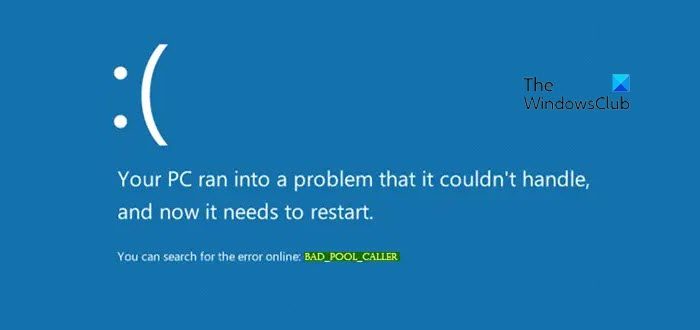Windows may be a very easy-to-use and a stable operating system, but at times you may find it throwing up errors. These are Stop Errors or Blue Screens. One of the frequently encountered Stop Errors is – BAD_POOL_CALLER with a value of 0x000000C2. In this article, we will share some information about this error, cause, and some suggestions to fix BAD POOL CALLER error in Windows 11/10/8/7.

Before getting into the solution, you should know the reason of this issue.
This particular problem occurs when a program tries to use a processor thread that doesn’t exist or is currently unavailable. Typically this is at a bad IRQL level or double freeing the same memory allocation. Also, if the same thread of the processor is being used by another program, it can cause the error. In other words, if a bad pool request has been made by a thread in the processor, you can get the BAD_POOL_CALLER stop error displayed on your screen.
When this happens, Windows takes quick action on such error codes. Your Windows computer restarts itself and runs a chkdsk test to protect the data from being damaged. Sometimes, it solves the issue, but it may not be helpful in all cases.
Fix BAD POOL CALLER Blue Screen on Windows
If you cannot boot into Windows normally, you should try to boot into Safe Mode and see if you can access these tools. If you had already enabled the F8 key earlier, things are easier as you press F8 while booting, to enter Safe Mode. Alternatively, you should boot to the Advanced Startup Options screen and then do the needful. If you cannot do either, then you may then have to boot into Windows 11/10 with your Windows Installation Media or Recovery Drive and select Repair your computer to enter Troubleshoot > Advanced Startup Options.
If the issue does not get resolved, you may try the following suggestions.
1] Activate Driver Verifier
Driver Verifier is an inbuilt tool of Windows that checks for unsigned drivers, the behavior of drivers, errors in the execution of driver code, drivers built for older versions of Windows, etc. using it; you can run a simple command to diagnose what is wrong with your drivers.
To get started, open Driver Verifier by searching for verifier.exe. On Windows 10, you can take the help of Cortana. Otherwise, search for it in Start Menu. Enable the memory pool options to obtain more information about these errors and to locate the faulting driver. Following that, you can set it up according to your issue and run the command after restarting your computer.
2] Update Device Drivers
Drivers are a common cause for causing Blue Screens, and so checking up and updating your Device Drivers to their latest available versions from the manufacturers is always a good idea.
3] Run Windows Memory Diagnostics
In the above suggestions have not worked for you, you should isolate physical memory. For that, you can use Windows Memory Diagnostics, which is another inbuilt tool of the Windows operating system. You may run the Windows Memory Diagnostics tool, to try and isolate the physical memory as a cause.
So open it up and select Restart now and check for problems. It will immediately restart your computer and start checking the physical memory for any issue. After the test is over, you should open the Event Viewer and view the MemoryDiagnostics-Results results under the System log.
This post will show you how to resolve the BAD POOL HEADER error.